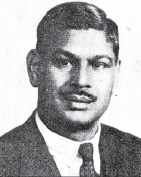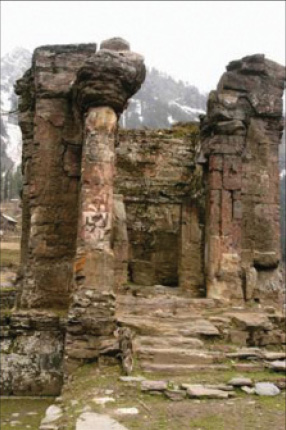The Role of
Ichamma Front in Saving Srinagar
By Raman Kumar
Bhat
The heroic role played by brave people like Major Som Nath Sharma
and his fellow soldiers in defending
Srinagar airfield
in 1947 has received good attention from historians. Unfortunately, the
chronicles penned down by military historians do not focus on the supportive
role played by the civilian population. In the context of defence of Srinagar
airfield in 1947 the heroic front put up by the Kashmiri Sikhs at Ichamma (Tangmarg)
has gone totally unnoticed. It is due to this effort that Pakistani raiders
could not mount any offensive on the airfield till October 31, 1947. This gave
Indian army enough time to shore up defences to protect the airfield and
ultimately save
Srinagar
from falling into the hands of Pakistanis. The situation remained critical in
the Kashmir valley on
28th October, 1947. The State government had just 60 state forces
troops and two companies to beat back the massive Pakistani invasion. The city
of Srinagar
was tense and uncertain about its fate. Few volunteers of the National
Conference tried to keep the panic at bay by staging parades with ‘wooden guns’
and defiant slogans. The enemy had everything-troop numbers, artillery, mortars
etc.
On 29th October Tactical Headquarters 161 Indian Infantry Brigade
was opened at the
Srinagar
airfield. During the day 56 men of 1 Sikh and 218 troops of 1 Kumaon
(Paratroops) were flown in, bringing the total number of troops flown to
Srinagar since 27 October to 941. On 29th October it was a touch and go
situation for the slender forces defending
Srinagar.
At 6:30 PM in the evening the Indian troops had to
retreat and take up positions astride the road at milestone 16 near Pattan.
There was another attack three hours later, troops had to be rushed to Pattan
from the airfield. The task of defending airfield fell on 1 (Para)
Kumaon Company which had just landed from the air.
The position on the night of October 29 remained serious. 1500
raiders were marching towards
Srinagar, taking
the route via Sopore and Bandipur. 500 invaders were trying to push directly
along the Baramulla-Srinagar road. These were the best equipped troops among the
raiders and were adequately supplied with mechanical transport, mortars and
machine guns. Another 200 raiders were trying to outflank the Pattan position
from the south by advancing down the Tangmarg road which met the
Baramulla-Srinagar road at Narbal.
While Indian forces did not allow the Invaders to move beyond
Pattan, the Sikh front at Ichama blocked the path of 200 raiders who were trying
to outflank the Pattan position by advancing from the Tangmarg side. It was only
after Pakistanis replenished their strength by bringing another 500 raiders near
Pattan that they were able to break the Sikh resistance at Ichama on the night
of 30th October. On
October 31st, 300-350 raiders were advancing from Pattan towards
Sumbal and Magam apparently to outflank the defenders’ positions near Pattan
from both sides.

Khurshid Anwar
Soon after breaking the resistance at Ichama by early hours of
October 31st, 40-50 Pakistani raiders led by Major Khurshid
Anwar entered Watterhail, a village on Beerwah-Budgam border in the evening of
October 31st. This batch of raiders included 10-12 regular Pak army men. Local
Muslim Conference MLA Pir Ziauddin played host to them. The raiders fanned out
in periphery of airfield on November 1 and 2nd. On 3rd November the battle of
Budgam took place in which 4 Kumaon Company was attacked by about 700 raiders at
2 PM. Despite initial setbacks, the Indian
forces succeeded in stopping the enemy advance on the airfield. Major Som Nath
Sharma achieved martyrdom. Before his death, he had sent the following memorable
message to his Brigade Hqrs. - “The enemy are only 50 yards from us. We are
heavily outnumbered. We are under devastating fire. I shall not withdraw an inch
but will fight to the last man and the last round”. The Indian troops which were
airlifted to
Srinagar
for defence of airfield had enrolled civilian volunteers as guides only on 1st
November. Holding the front by the Sikhs at Ichamma till late hours of 30th
October gave enough time to Indian army to bolster defences for the airfield and
ultimately turn the tide against Pakistanis in the battle of Budgam on 3rd
November.
Ichama, a village in
Tosaimaidan
Valley separates Budgam from Tangmarg region. In 1947 this village was a
Sikh-dominated one and had a big Gurudwara for worship. The two Kashmiri Pandit
families of Pt. Raghav Ram Ambardar and Pt. Sona Ram Razdan lived in the
neighbouring village of Larikpora. Pt. Raghav Ram was a well-to-do landlord of
the area. He also ran a shop in Kham Hamchipora, 1½ kms from Larikpora.
Mohammad Khan, a Gujjar and resident of Kham Hamchipora had been to
Uri, where he had learnt about the raiders’ attack. He cautioned Dina Nath, son
of Pt. Raghav Ram”, war is going on. You have to be careful. Don’t wait till it
is too late”. Pt. Tika Lal Jailkhani, an employee in the State Forest Department
overheard the conversation. He tried to allay fears of Pt. Dina Nath by arguing
that the Indian Army had already reached
Srinagar. Pt.
Tika Ram even asked him to arrange singing mehfil for the night. Lulled into
false confidence, Ambardars decided to stay back in the village.
The following morning while going home Dina Nath saw fires raging
all over. The Sikh refugees, fleeing from Kupwara and Baramulla areas, made
Ichama their destination. They passed via Larikpora. Ichama became new morcha
after the collapse of Bulgam front near Baramulla. The gallant Sikhs who had
suffered heavily in Muzaffarabad, Ningal, Bulgam and other areas decided to
block raiders at Ichama.
The
village
of Ichama is located at the foot of a Valley formed by two hillocks. In 1947
more than 60 Sikh families lived here. The neihbouring villages also housed
sizeable Sikh population. Many of them had served in State Forces. There is no
circumstantial evidence to suggest that the Maharaja’s government had aided the
effort of civilian resistance at Ichama.
On 28th of October as Pt. Sona Ram Razdan’s family sat down for
dinner Ahmad Lone of Allapora dropped by. He had crossed Ferozpur nullah to
inform Kashmiri Pandits that the raiders had already reached Yaal, a village 2
kms from Larikpora. He further told them that the raiders had gunned down Pt.
Tara Chand, a close relation of Pt. Sona Ram.
It was 9:30 PM Pt. Sona Ram’s family left for Arizabji. Loyal
villagers - Aziz Wani, Wahab Wani and Lassa Parra carried the little bedding and
the cooked rice for them. Arizabji is known for its scenic beauty and housed
around 25 Sikh families. The Pandit family sought shelter in the house of Sh.
Darshan Singh Bali. Arizabji is located at an elevation.
The same evening one of the acquaintances from the majority
community had visited Pt. Raghav Ram Ambardar to inform him that his sister’s
husband, Pt. Sham Lal of Tarahama has been shot dead by the raiders. This shook
Pt. Raghav Ram. He was two weak to walk. He stuffed gold sovereign and silver
coins into a bag. Pt. Shavjee, the family servant, loaded it on his back as
Ambardars moved to Arizabji. With the support of a stick Pt. Raghav Ram managed
to reach Arizabji.
A little later, the Yaal relations of Pt. Sona Ram reached
Larikpora. The local villagers informed them that the Pandit families had moved
to Arizabji. So they too left for Arizabji. It was around
midnight when loud cries of ‘Ovah Ha Ovah Ha’ (They
have come, they have come) reverberated in the air. The Pandit families and the
Arizabji Sikhs immediately left for Ichama which was 1½ mile away.
Thousands of Sikhs, having fled from their homes in Baramulla
district, had assembled here. Many of them were ex-servicemen. The Sikhs carried
swords and rifles but had no artillery.
Had they been equipped with sophisticated weaponry, perhaps the
outcome could have been different. Ichama had a big Gurudwara, with Dharamshalas
around it. Some of the refugees were housed in the Dharmshalas, while most of
the people put up in the open space of Gurudwara. A langar fed refugees day and
night. Males and females attended to the kitchen, the Pandit families also
helped in the kitchen work. The kitchen was run in a Kashmiri style long Vurah (Chulha).
As food items started depleting Pt. Raghav Ram replenished these
from his home. He contributed substantially to keep the langar running and had
also got lot of bedding and blankets from his home for the refugees. It was
bitter cold. Ichamma is located between two hillocks. The Raiders had taken up
positions at the heights between Iskanderpora and Astanpora. Sikh volunteers
conducted patrolling on horses and had taken positions behind the houses. Sikh
houses were in close vicinity of Gurudwara. Suddenly in the evening of 30th
October as darkness set in the raiders opened incessant firing. The Sikhs were
well-armed but had the disadvantage of terrain. Firing continued for half on
hour. This was replied well by the Sikhs. As the raiders’ firing stopped the
Sikhs thought that the raiders had left. Others told them that the raiders had
gone to take food. The Sikhs had limited ammunition and food provisions. After
the firing stopped the people who had assembled in Ichama started moving towards
the Karewa on way to Arvah. Elderly people advised them to maintain silence and
not to lit any match stick lest it betray their movement to the raiders.
The people had hardly moved half a mile when raiders ambushed them.
They came out from beravtal (field demarcations) and bothtal (clay covers) etc.
and began firing indiscriminately on the people. Hundreds of people died in
firing, many others got crushed in the stampede. The people who were at the
front and in the middle suffered the worse, very few of them survived. As per
eyewitnesses corpses lay all around.
The survivors who were in the rear moved back to Ichama. Mrs.
Shobawati, wife of Sh. Dina Nath was pregnant. She received penetrating gunshot
injury on her hand. Pt. Sona Ram Razdan took out his turban and bandaged it on
her bleeding hand. Unable to carry her three year old daughter with an injured
hand, she dropped her near a bush.
Hardly ten minutes had passed when refugees had reached Ichama then
the firing was resorted to again by the raiders. The Sikhs had run short of
ammunition and their number had also substantially depleted. A decision was
taken that survivors among refugees would assemble in two three-storeyed
Dharmshalas and would commit self-immolation instead of falling into the hand of
raiders. The women and children were weeping and wailing, feeling totally
helpless. The Granthi asked refugees to wait for ten minutes before taking any
hasty decision.
Suddenly, the firing stopped. Meanwhile, a raider entered the
Dharmshala compound. Carrying magazines around his neck, he positioned himself
to open firing on the last survivors. Before he could do it, the volunteers
fired at him. As the raider did not relent, the lady volunteers dragged him in
and hit him with swords.
The Granthi now asked refugees to thank God that they had survived
against all odds and asked them to quickly leave the place for
Srinagar. As the
refugees moved down Ichama they heard cries of 3 year old Sheela. Channa Kak
picked her up. Before sunrise the refugees reached Shalteng. The Army shifted
them to relief camps in
Srinagar.
Source: Kashmir
Sentinel
| 














No one has commented yet. Be the first!